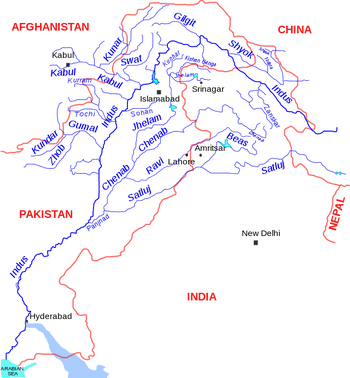Ravi River
| Author:Laxman Burdak, IFS (Retd.) |

Ravi River (Hindi: रावी, Punjabi: ਰਾਵੀ, Urdu: راوی ) is a trans-boundary river flowing through Northwestern India and eastern Pakistan. It is one of the six rivers of the Indus System in Punjab region.
Variants of name
- Ravi River (Anabasis by Arrian, p. 300.)
- Ravi River रावी दे. Iravati River (इरावती नदी) (AS, p.796)
- Sharavati शरवती = Saravati सरावती = Ravi River रावी (AS, p.891)
- Saravati सरवती = Sharavati शरवती दे. शरावती (AS, p.938)
- Iravati River (इरावती नदी) (AS, p.79)
- Airavati (ऐरावती)
- Hydraotes (Greek)
- Iravati (इरावती)
- Parushni (परुष्णि)
- Paroshni (परोष्णि) (Rajatarangini)
- Irrawati/ Irravati
- Iravadi (इरावदी)
- Kakuttha (कुकुत्था)/Kukuttha (कुकुत्था) दे. Iravati (इरावती) (2) (AS, p.124)
- Payoshni River (पयोष्णी) = Parushni (परुष्णी) (AS, p.529)
- Parushni परुष्णी (p.532)
History
According to ancient history traced to Vedas, the Ravi River was known as Iravati (also spelt Airavati).[1]
Part of the battle of the ten kings was fought on a River, which according to Yaska (Nirukta 9.26) refers to the Iravati River (Ravi River) in the Punjab.
Rajatarangini[2] tells....When Koshtaka with Lothana had departed from (Lohara), neither Mallarjjuna nor Koshtaka nor Lothana remained the sovereign of the country. Mallarjjuna killed Udayana who was on his side through treachery. On this Koshtaka who had been appointed umpire between them became very angry with Mallarjjuna. Koshtaka then collected a force, and he did not show himself inferior to Mallarjjuna, and accompanied by Lothana, he marched rapidly in anger to confront Mallarjuna. He joined few" horsemen headed by Mallakoshta, crossed the river Paroshni and crushed a weak army [ of the enemy. ] [VIII(i)],p.177]
Course
The Ravi River originates in the Himalayas in the Multhan tehsil of Kangra district of Himachal Pradesh, India.
Ravi River flows through the base of Dalhousie hill, past the Chamba town. It flows into the south-west, near Dalhousie, and then cuts a gorge in the Dhauladhar Range, before entering the Punjab plain near Madhopur and Pathankot. It then flows along the Indo–Pak border for 80 kms before entering Pakistan and joining the Chenab River.
As the Ravi flows past Lahore in Pakistan, 26 kms below Amritsar in India) it is called "The river of Lahore" since that city is on its eastern bank. After passing through Lahore the river takes a turn at Kamlia and then debouches into the Chenab River, south of the town of Ahmadpur Sial. On its western bank is the town of Shahdara Bagh with the tomb of Jahangir and the Tomb of Noor Jahan.
रावी नदी
रावी नदी: पंजाब की प्रसिद्ध नदी - प्राचीन इरावती. दे. Iravati River (इरावती नदी) (AS, p.796)
परुष्णी नदी
विजयेन्द्र कुमार माथुर[3] ने लेख किया है ...परुष्णी नदी (AS, p.532) पंजाब की प्रसिद्ध नदी रावी नदी या इरावती नदी का वैदिक नाम है। परुष्णी नदी का ऋग्वेद मंडल 10 सूक्त 75 नदी सूक्त में उल्लेख है:- 'इमं में गंगेयमुने सरस्वती शुतुद्रिस्तोमं समता परुष्णया असिकन्या मरुद्वृधे वितस्तयार्जीकीये श्रृणृह्मा सुषोमया'। जान पड़ता है कि परुष्णी नाम वैदिक काल में ही प्रचलित था क्योंकि परवर्ती साहित्य में इस नदी का नाम इरावती मिलता है। [p.533]: अलक्षेंद्र के समय के इतिहास लेखकों ने भी इस नदी को ह्यारोटीज (Hyarotis) लिखा है जो इरावती का ग्रीक उच्चारण है। रावी इरावती का ही अपभ्रंश है।
ऋग्वेद के अनुसार परुष्णी नदी के तट पर ही तृत्स गण के राजा सुदास ने दस राजाओं की सम्मिलित सेना को हराया था। यह युद्ध 'दाशराज युद्ध' के नाम से प्रसिद्ध हुआ था। सुदास ने, जिसका राज्य परुष्णी के पूर्वी तट पर था, पश्चिम से आक्रमण करने वाले नरेश-संघ की सेना को नदी पार करने से पहले ही परास्त कर पीछे ढकेल दिया था। ऋग्वेद 8,74 (सत्यमित्वा महेनदि परुष्णयवदेदिशम् आदि) में परुष्णी के निकट अनु के वंशजों का निवास बताया गया है। अनु ययाति का पुत्र था। वैदिक काल के पश्चात् इसी प्रदेश में मद्रक तथा केकय बस गए थे। (दे. इरावती नदी-1)
इरावती
विजयेन्द्र कुमार माथुर[4] ने लेख किया है ...
1. इरावती नदी (AS, p.79): पंजाब की प्रसिद्ध नदी रावी है। रावी इरावती का ही अपभ्रंश है। इरावती का वैदिक नाम परुष्णी था। 'इरा' का अर्थ मदिरा या स्वादिष्ट पेय है। महाभाष्य 2,1,2 में इरावती का उल्लेख है।
महाभारत, भीष्मपर्व 9,16 में इसको वितस्ता और अन्य नदियों के साथ परिगणित किया गया है- 'इरावतीं वितस्तां च पयोष्णीं देवकामपि'।
सभा पर्व महाभारत 9,19 में भी इसी प्रकार उल्लेख है- 'इरावती वितस्ता च सिंधुर्देवनदी तथा।'
ग्रीक लेखकों ने इरावती को हियारावटाज लिखा है।
2. इरावती नदी (AS, p.79): इरावती पूर्व उत्तर प्रदेश की राप्ती का भी प्राचीन नाम इरावती था। यह नदी कुशीनगर के निकट बहती थी जैसा कि बुद्धचरित 25, 53 के उल्लेख से सूचित होता है- 'इस तरह कुशीनगर आते समय चुंद के साथ तथागत ने इरावती नदी पार की और स्वयं उस नगर के एक उपवन में ठहरे जहाँ कमलों से सुशोभित एक प्रशान्त सरोवर स्थित था'। अचिरावती या अजिरावती इरावती के वैकल्पिक रूप हो सकते हैं। बुद्धचरित के चीनी-अनुवाद में इस नदी के लिए कुकु शब्द है जो पाली के कुकुत्था का चीनी रूप है। बुद्धचरित 25, 54 में वर्णन है कि निर्वाण के पूर्व गौतम बुद्ध ने हिरण्यवती नदी में स्थान किया था जो कुशीनगर के उपवन के समीप बहती थी। यह इरावती या राप्ती की ही एक शाखा जान पड़ती है। स्मिथ के विचार में यह गंडक है जो ठीक नहीं जान पड़ता। बुद्धचरित 27, 70 के अनुसार बुद्ध की मृत्यु के पश्चात् मल्लों ने उनके शरीर के दाहसंस्कार के लिए हिरण्यवती नदी को पार करके मुकुटचैत्य (देखें मृकुटचैत्यवंधन) के नीचे चिता बनाई थी। संभव है महाभारत सभा 9, 22 का 'वारवत्या' भी राप्ती ही हो।
3. इरावती नदी (AS, p.79): ब्रह्मदेश की इरावदी. इरावदी नाम प्राचीन भारतीय औपनिवेशिकों का दिया हुआ है।
In Mahabharata
References
- ↑ Hastings, James (2003). Encyclopedia of Religion and Ethics, Part 18. Kessinger Publishing. p. 605. ISBN 0-7661-3695-7.
- ↑ Kings of Kashmira Vol 2 (Rajatarangini of Kalhana)/Book VIII (i),p.177
- ↑ Aitihasik Sthanavali by Vijayendra Kumar Mathur, p.532
- ↑ Aitihasik Sthanavali by Vijayendra Kumar Mathur, p.79

